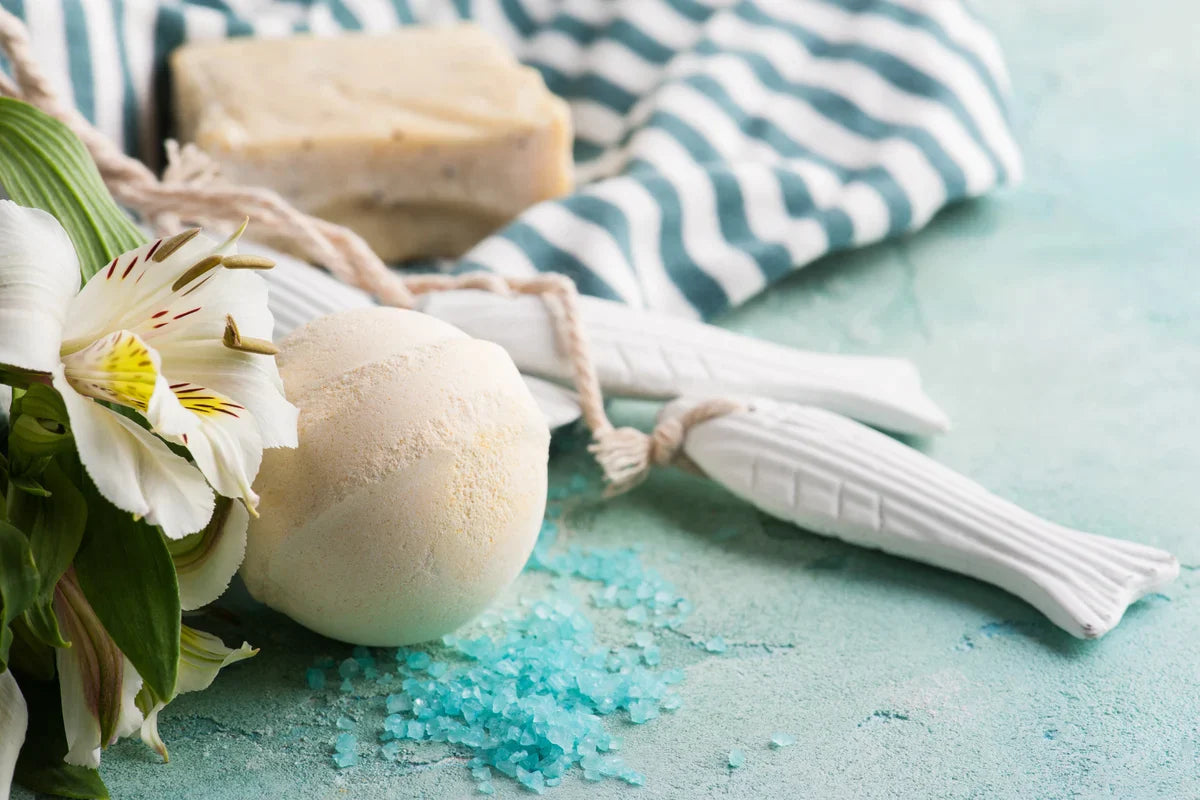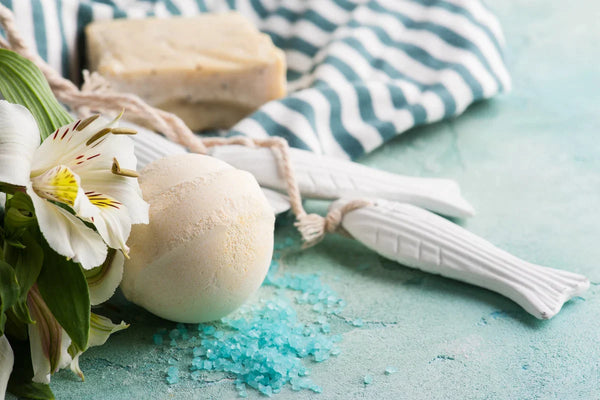A nautical bathroom design brings to mind the sea, sunshine and days of relaxation. That is why it is one of the most popular designs for the home. Bright bathrooms with natural materials, clean lines and beach colors can make you feel like you are on vacation — whether you live near the coast or inland.
The biggest thing you need to keep in mind is that a nautical design can easily be overdone. Here, the experts weigh in on how to keep nautical classy.
Nautical and Coastal Design
Nautical design is all about evoking the sea. The term is often used synonymously with coastal design because both are derived from beach living. Whatever term you use, beach inspired homes have been popular in American homes for centuries.
“After the American colonies were formed in 1607, domestic spaces began drawing inspiration from Europe’s Georgian and Neoclassical trends, but with a pared-down look,” says the team at Invaluable.com. “New England interiors eventually developed their own nautical flair, which was influenced by the properties of the region’s unique geographic location and proximity to the eastern shoreline.” The New England shoreline inspired what we traditionally think of beach cottage style — a cozy and clean decor that reflects an easy-going pace of life.
Coastal design, however, is not limited to beach cottages on New England shores, says home decor writer Tonya Lee. Coastal design also encompasses Tropical Island Coastal and Mediterranean Coastal styles. These subsets of nautical design are based in coastal living — but infused with the colors and materials present in areas like tropical islands, Italy or Greece.
Even though nautical and coastal design are often used interchangeably, Sienna Livermore at House Beautiful says there is a big difference between the two. Nautical design conveys blue and white colors, seashells and anchors. Coastal design simply means beachy.
There is room for interpretation, but ultimately what you are after here is a style based on colors, light and elements found in seaside communities.
“If you’re looking for a great descriptive term for it, “minimalistic elegance” is probably the most accurate,” says Marc Schenker of the Glorious Company. “Every aspect of this design trend is intended to provide some sort of escapism and reprieve—whether visual or spatial—from the stresses and rigors of everyday life.” Coastal design is a style influenced by nature and moods you feel at the beach. It feels clean, beautiful and airy — not filled with clutter, kitsch accessories or over-the-top blue walls.
The following elements can be used together to create a relaxing space that makes you feel just as free as a day at the beach.

Fill Your Bathroom with Colors that Reflect the Seaside
Coastal communities are filled with natural colors — ranges of blue, greens, and neutrals. These colors are easily incorporated into a bathroom to give the space a retreat-like feel.
“Nautical themes are most often interpreted with the use of calm, soothing colors in creams, light browns, pinks, sea foam greens, white, pinks and blues,” says Maria McCutchen at Nimvo. “If you want to create a deeper, richer theme, use darker blues and richer browns in your design.” The most quintessential nautical bathroom contrasts blue walls with white trim.
On the other hand, you can paint in whites or neutrals to create the nautical flair, explains Jennifer Ebert at Ideal Home. Keeping the color scheme nude, reminiscent of sand, is elegant. If you love blue and white, paint the bathroom walls white, and add blue accessories, fixtures and linens.
Gray is another option, writes the team at counter tops and tiles provider WOMAG. It pairs well with natural materials common in beach homes such as distressed wood.
Greens, yellows, or even reds are also viable options if you want to break conventional beach-style norms. Interior design writer Deirdre Sullivan gives examples of how to incorporate different patterns and colors in a beach bathroom. The looks range from tropical and retro to coastal charm and pristine white.
It is important to choose what you personally enjoy as long as the color scheme complements the lighting, fixtures and other design choices in your bathroom.
Use Natural Materials to Keep Things Fresh
When we think about the beach, we might first imagine the blues of the sky and water meeting on the horizon, but then our mind goes to the other details, such as driftwood, palm trees, pebbles and kelp. These natural materials influence the flooring and accessories you choose to incorporate into your coastal bathroom setup.
Wood is one of the most popular materials to use in coastal bathrooms to give the space a more warm and natural atmosphere. Kara Ladd at Elle Decor says that using reclaimed wood and white marble textiles, for example, makes for a “clean contrast just like a wood dock against a white sand beach.” Wood can be used as flooring, a bench or other accessories.
You may be tempted to use synthetic materials but the designers at Décor Aid recommend using natural material. “Wood, cotton, and jute will work to add a touchable sense of luxury to coastal decor while providing a comfortable and cozy energy.” The amount of natural materials you use can vary depending on your preferences. You can choose to use shiplap for your bathroom walls or you can use natural materials you’ve collected on vacation to make your own beautiful accessories.
Simona Ganea at Homedit offers ideas of how you can use driftwood to make beautiful and trendy decorations for your home. Many people choose to use a coastal style in their home because of all the memories they have from the beach. What better way to bring style and emotional satisfaction together than by seeing your collected materials on display in your bathroom?
Stone is another natural material to keep in mind for your bathroom flooring, walls, or decor. It can also be used in your shower, just like this bathroom in San Diego by Signature Designs. Be sure to read up on maintenance of stone in the bathroom because it does require sealant.

Your Tile Choices Matter
Your tile choices can be an element to play with color and add to the overall balance of your bathroom.
“It is easy to achieve the right look by having bathroom tiles of white or blue, and floor tiles of white, blue or sea green,” says Andreea at ImpressiveInteriorDesign. If your walls are white or neutrally colored, you may choose to use blue tile for added color or you could continue the neutral theme by choosing a stone tile.
Designer Courtney Blanton plays with blue and white tiled bathroom floors in the bathroom to create a beautiful coastal feel. Another option is to choose a neutral tile and add a blue bath mat to reflect ocean hues.
Tiles aren’t limited to floors. They can be added to walls or your shower.
Because many beach bathrooms rely on neutral colors, it can be fun to add a pop of color. “We are including a lot more bright-colored tile accents than ever before, such as cement tile, penny rounds, colorful herringbone patterns—mainly for shower wall accents,” says custom home builder Marnie Oursler.
Look at design blogger Will Taylor's guest bathroom at his beach house for an example of tile use. “In the guest bathroom we used Ogee Drops in Naples Blue for the walk-in shower area with Mini Star & Cross in White Wash on the floor, and 3×6 subway tile in White Wash on the walls,” he writes. The curved blue tiles in the shower are reminiscent of waves and pair well with the lemon wallpaper. Bright tile colors can create a beach energy in the bathroom without going overboard.
Combine Coastal Elements with Other Home Designs
Coastal living is all about relaxation but if you try too hard, the bathroom elements can go from tasteful to too much very quickly. One way to strike a balance is to work with another interior design scheme and add coastal elements.
“How coast and the open water are actually embodied within a home, well, there is a very broad design arc available,” says structural engineer Amber Dickson. “It can be expressed in serene, minimal spaces, as well as rustic and collected homes. Consider the preppy, modern Ralph Lauren interiors compared to the relaxed island vibe of India Hicks.” Choose the style that you really love — minimalism, maximalism, rustic or farmhouse — and mix beach elements within this design.
“While beach style is often considered easy and breezy, there's no reason why those who like their home to be a little more lavish can't partake,” says interior decorator Lauren Flanagan. “This elegant living room from Stephan Alexander Homes adds a little bit of glam to the relaxed style with mirrored coffee tables, delicate details and oodles of accessories.” Don’t be afraid to mix and match styles. Unexpected twists can make coastal living look new and fresh, rather than cliche.
If you are adding coastal elements to your bathroom via artwork and accessories, accessorize lightly, and your beach bathroom will feel like your own personal oasis.
Images by: Iryna Bort/©123RF.com, Monika Mlynek/©123RF.com, iriana88w/©123RF.com






